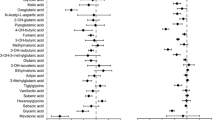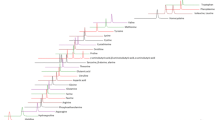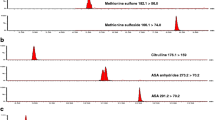Abstract
Organic acid (OA) analysis is a specific test for inherited metabolic disorders (IMDs); however, the previous detection methods are laborious and costly. This study aims to develop a rapid method for the simultaneous quantification of serum and urine OA profiles. The method was established based on the liquid chromatography-tandem mass spectrometry (LC–MS/MS) technique. The specificity, sensitivity, robustness, and accuracy of the established method were validated. Fifteen healthy subjects and nine IMD patients were measured for clinical validation. OAs with their intrinsic isomers were completely separated. The LC–MS/MS analysis time was 5.5 min. Calibration curves were linear within the ranges of 27.00 μg/g for all OAs. The average correlation relationship (R) varied from 0.9891 to 0.9998. The limit of detection and limit of quantification varied from 0.003 to 0.07 μg/g and 0.006 to 0.08 μg/g, respectively. No obvious carryover was observed. The intra-assay, inter-assay, and total imprecisions were 1.22–4.14%, 0.90–5.20%, and 1.67–5.90%, respectively. The mean spiked recovery at the three levels varied from 94.31 to 106.68%. The matrix effects can be compensated for by internal standard correction. Nine IMD patients were identified. A robust LC–MS/MS method for the rapid determination of serum and urine OA profiles without derivatization or liquid–liquid extraction was developed and validated. The analysis of five common OAs can be completed in short minutes. This innovative LC–MS/MS method for OA profiles may present its potential in future rapid screening and diagnosis of IMDs.
Graphical abstract










Similar content being viewed by others
References
Ferreira CR, Rahman S, Keller M, Zschocke J ICIMD Advisory Group. An international classification of inherited metabolic disorders (ICIMD). J Inherit Metab Dis. 2021;44(1):164–77.
Centers for Disease Control and Prevention (CDC). Good laboratory practices for biochemical genetic testing and newborn screening for inherited metabolic disorders. MMWR Recomm Rep. 2012;6;61(RR-2):1–44.
Sun W, Wang Y, Yang Y, Wang J, Cao Y, Luo F, et al. The screening of inborn errors of metabolism in sick Chinese infants by tandem mass spectrometry and gas chromatography/mass spectrometry. Clin Chim Acta. 2011;412(13–14):1270–4.
Kimura M, Yamamoto T, Yamaguchi S. A personal computer-based system for interpretation of gas chromatography mass spectrometry data in the diagnosis of organic acidaemias. Ann Clin Biochem. 1999;36(Pt 5):671–2.
Christou C, Gika HG, Raikos N, Theodoridis G. GC-MS analysis of organic acids in human urine in clinical settings: a study of derivatization and other analytical parameters. J Chromatogr B Analyt Technol Biomed Life Sci. 2014;964:195–201.
Nakagawa K, Kawana S, Hasegawa Y, Yamaguchi S. Simplified method for the chemical diagnosis of organic aciduria using GC/MS. J Chromatogr B Analyt Technol Biomed Life Sci. 2010;878(13–14):942–8.
Yost RA. Why tandem mass spectrometry for trace analysis: Concepts of tandem analytical techniques. Rapid Commun Mass Spectrom. 2022;36(13):e9310.
Banerjee S. Empowering clinical diagnostics with mass spectrometry. ACS Omega. 2020;5(5):2041–8.
Wang Z, Wang H, Peng Y, Chen F, Zhao L, Li X, et al. A liquid chromatography-tandem mass spectrometry (LC-MS/MS)-based assay to profile 20 plasma steroids in endocrine disorders. Clin Chem Lab Med. 2020;58(9):1477–87.
Avataneo V, D’Avolio A, Cusato J, Cantù M, De Nicolò A. LC-MS application for therapeutic drug monitoring in alternative matrices. J Pharm Biomed Anal. 2019;166:40–51.
Ueyanagi Y, Setoyama D, Kawakami D, Mushimoto Y, Matsumoto S, Hotta T, et al. Fully automated quantitative measurement of serum organic acids via LC-MS/MS for the diagnosis of organic acidemias: establishment of an automation system and a proof-of-concept validation. Diagnostics (Basel). 2021;11(12):2195.
Blom HJ, van Rooij A, Hogeveen M. A simple high-throughput method for the determination of plasma methylmalonic acid by liquid chromatography-tandem mass spectrometry. Clin Chem Lab Med. 2007;45(5):645–50.
CLSI. C-62A: Liquid chromatography-mass spectrometry methods; approved guideline. Wayne: Clinical and Laboratory Standards Institute; 2014.
Yu S, Wang D, Ma X, Zhang Y, Sun D, Zou Y, et al. Analytical and clinical performance of a liquid chromatography-tandem mass spectrometry method for measuring gastrin subtypes G34 and G17 in serum. Clin Chem. 2021;67(9):1220–9.
Ma X, Zou Y, Tang Y, Wang D, Zhou W, Yu S, et al. High-throughput analysis of total homocysteine and methylmalonic acid with the efficiency to separate succinic acid in serum and urine via liquid chromatography tandem mass spectrometry. J Chromatogr B Analyt Technol Biomed Life Sci. 2022;1193: 123135.
Acknowledgements
We are grateful for the kind help from Dr. Xueyan Han (Department of Medical Statistics, Peking University First Hospital, Beijing, China) in language editing.
Funding
This work was supported by the National Key Research and Development Program of China (2018YFC1002204).
Author information
Authors and Affiliations
Contributions
All authors have accepted responsibility for the entire content of this manuscript and approved its submission.
Corresponding authors
Ethics declarations
Ethics approval
The study was approved by the Ethics Committee of Beijing Hospital.
Competing interests
The authors declare no competing interests.
Source of biological material
Validation samples were collected in the Department of Laboratory Medicine of Beijing Hospital; patient samples were donated by Inner Mongolian Maternity and Child Health Care Hospital; Zhejiang Biosan Biochemical Technologies Co., Ltd.
Statement on animal welfare
Not applicable.
Additional information
Publisher's note
Springer Nature remains neutral with regard to jurisdictional claims in published maps and institutional affiliations.
Supplementary Information
Below is the link to the electronic supplementary material.
Rights and permissions
Springer Nature or its licensor holds exclusive rights to this article under a publishing agreement with the author(s) or other rightsholder(s); author self-archiving of the accepted manuscript version of this article is solely governed by the terms of such publishing agreement and applicable law.
About this article
Cite this article
Jin, L., Liu, Z., Zeng, J. et al. A simple method for rapid screening and diagnosis of common organic acidemias: quantitative detection of serum and urine organic acid profiles based on liquid chromatography-tandem mass spectrometry. Anal Bioanal Chem 414, 7823–7837 (2022). https://doi.org/10.1007/s00216-022-04316-9
Received:
Accepted:
Published:
Issue Date:
DOI: https://doi.org/10.1007/s00216-022-04316-9




